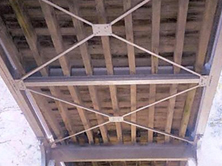 Steel girders supporting floorbeams and deck at no-longer-extant Ridge Street Bridge (Anson County Bridge 88), built in 1910 (source: NCDOT bridge inspection files)
Steel girders supporting floorbeams and deck at no-longer-extant Ridge Street Bridge (Anson County Bridge 88), built in 1910 (source: NCDOT bridge inspection files) Steel-girder-and-floorbeam bridges consist of two or more longitudinal beams or girders supporting transverse floorbeams and a deck.
As early as 1847, wrought iron, girder-and-floorbeam bridges were introduced by the railroads because of their primary advantage: they were strong, stiff structures of built-up, riveted girders capable of carrying heavy loads. The technology was very popular by the late 19th century. It was efficient and economical for railroad spans, because railroads had the equipment to transport and place the heavy girders. It was the only serious competitor to truss technology in the late 19th century.
Most extant 19th-century girder-floorbeam bridges and many 20th-century ones are associated with railroads. The oldest surviving highway-carrying examples in North Carolina are railroad-built overpasses dating from the 1910s. These included the Ridge Street Bridge (Anson County Bridge 88) over the Winston-Salem Southbound Railway in Ansonville, built in 1910.
In contrast to the railroads, the State Highway Department made sparing use of the girder-and-floorbeam bridge type for the development of the primary highway system because of the difficulty transporting the heavy, built-up, steel girders. The bridge maintenance unit did, however, extensively use a lightly built, girder-and-floorbeam design of all rolled-section beams on the secondary system.
The standard design of spans 30- to 50-feet-long and widths of 18 to 24 feet, adopted in 1941, addressed the need for an economical steel bridge designed for 10-ton truck live loads, The bridge maintenance unit purchased large quantities of beams, stocked them in maintenance yards around the state, and used its own workforce to construct the bridges using a minimum of heavy equipment.
The bridges helped meet the demands of the secondary road improvement campaigns promoted by Governors Robert Gregg Cherry (1945-49) and W. Kerr Scott (1949-53).
The Great Depression led to deferred maintenance and the use of temporary, untreated, timber stringer bridges over much of the secondary system. In response to the popular feeling that the state had not met its promise of improving rural roads, the period after World War II was one of upgrading and improving these roads and their bridges.
Standard girder-and-floorbeam bridges were built by the hundreds and played an important role in a bridge replacement effort that was so complete that few bridges from before 1946 remain on the secondary system today.